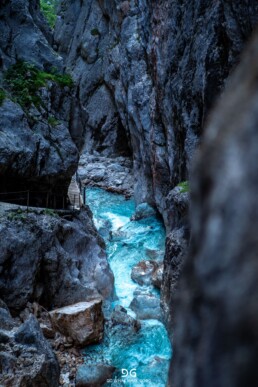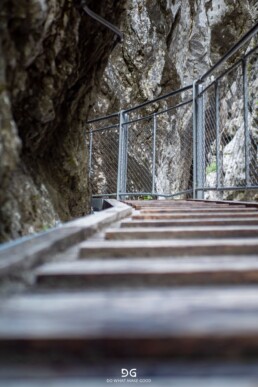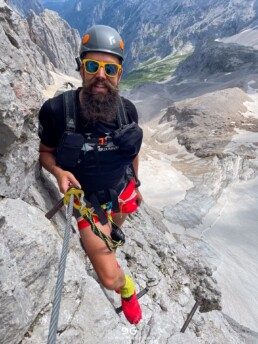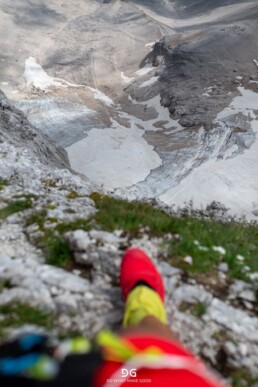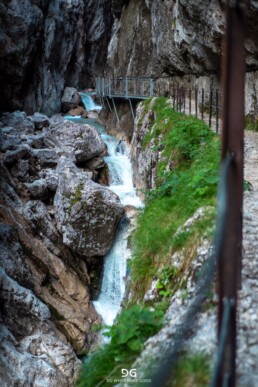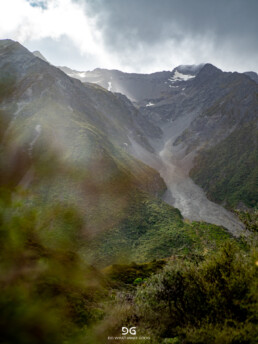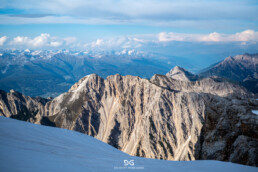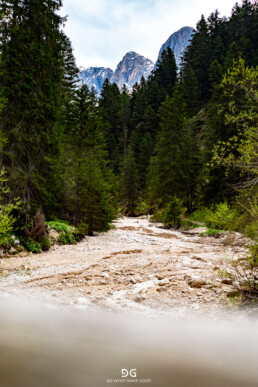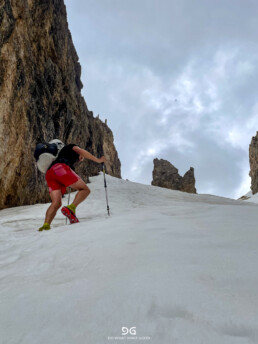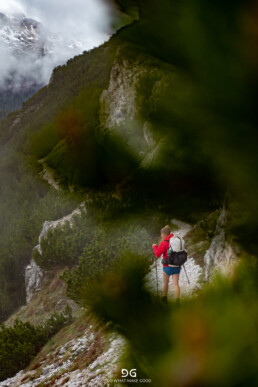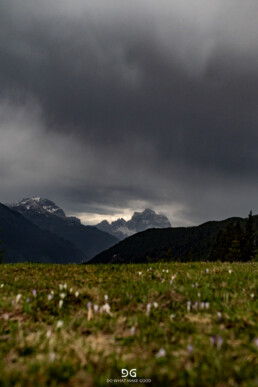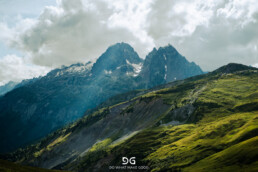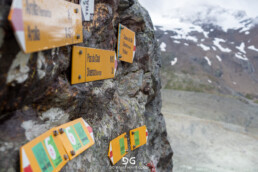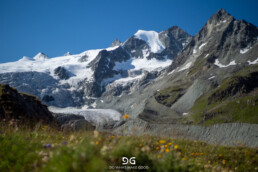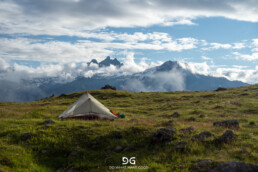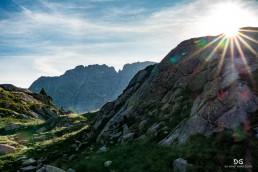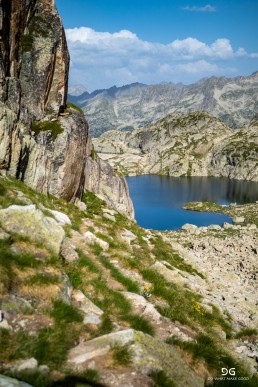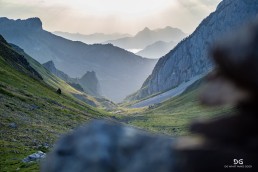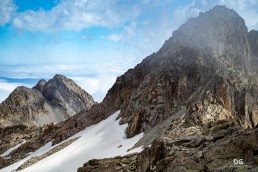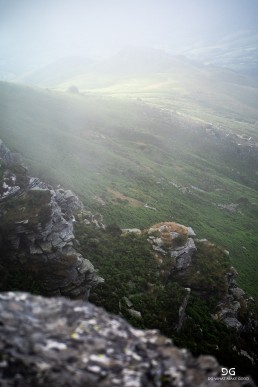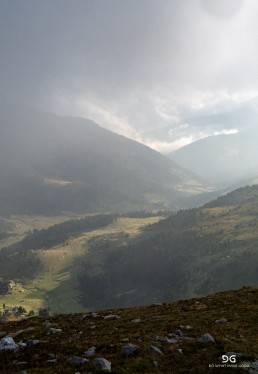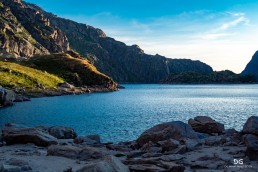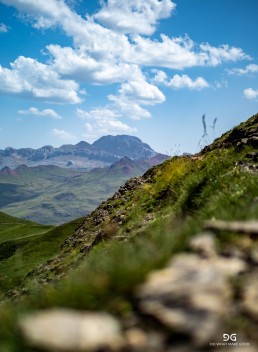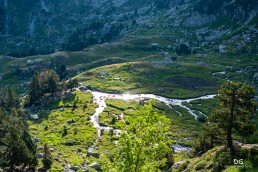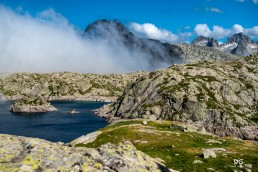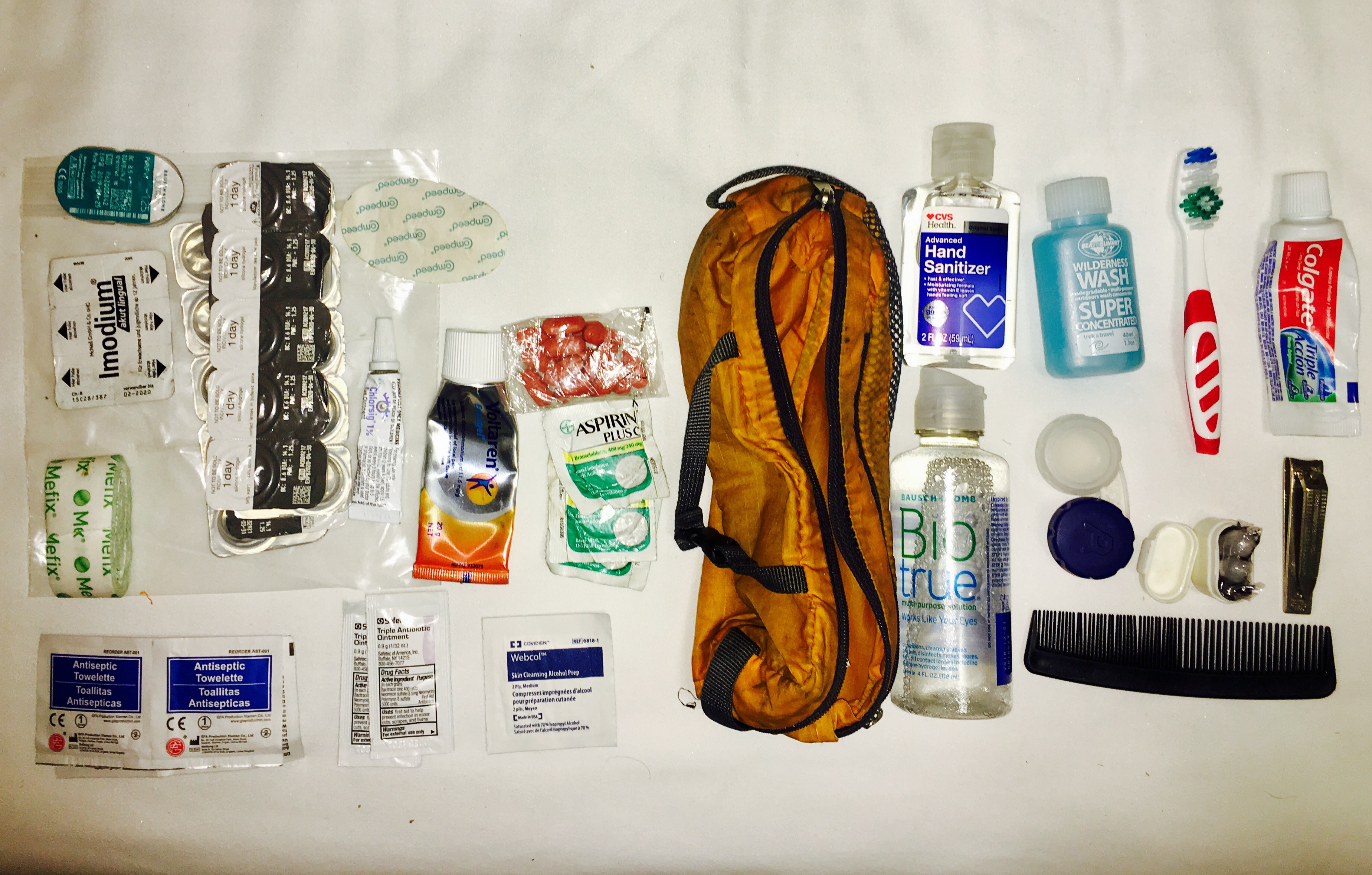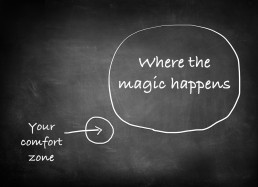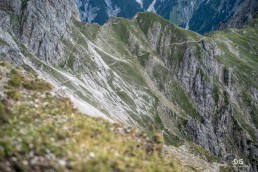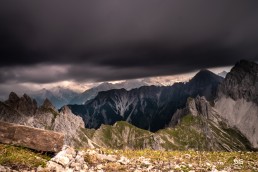Zugspitze
2023: Zugspitze
Quick hike through the Höllental up to the Top of Germany. A little bit more crowed than I hoped but what an amazing hike. First through the Höllental with it's gorgeous waterfalls into the via ferrata up over the remaining ice field before you get the to the final 600 meters in elevation through a pretty much straight wall. Not too heavy, nicely exposed in some stretches but great to walk. On the way down via the Austrian side to the famous Eibsee for a little dip. 2.300m elevation gain - 12h up and down with a little beer-break on top. Perfect day!
Dolomites High Route #9
2023: Dolomites High Route #9
The route #9 goes from Bolzano (Bozen) passing Cortina and Sexten all the way to Santo Stefano. On the way you pass the impressive sites of Piz Boe, Plattenkofel, Three Cinnes and the Alpini-Steig. We went before the season in the first week of June and ended up in waist deep snow from 2.400m, a fair amount of rain and a few turn backs from via ferratas which were to sketchy. But therefore we had the entire trail to ourselves and camped on the most epic spots totally alone.
Haute Route - Chamonix to Zermatt
2021: Haute Route - Chamonix to Zermatt
In 2021 I hiked the famous Haute Route from Chamonix to Zermatt. It's a beautiful 220km hike over some spectacular passes of the Swiss Alps.
I again decided to hike with my tent and spend the nights outdoors. The right decision even though it was pretty cold for this time of the year - I realised when I woke up to a frozen sleeping bag. A very mystical encounter with some ibex in the National Park and many, many beautiful mountains 😍
HRP - Pyrenean Haut Route Gear List
Background
I have hiked the Tour de Mont Blanc (TMB) in 2018 after having done the Te Araroa in 2016 and the Pacific Crest Trail in 2017. So I had accumulated a lot of hiking and long distance experience. On these two long distance trails I tried out a lot of different gear and also learned a lot. When I started in New Zealand I was completely over-packed! I had a 75l backpack and carried about 16kg of base weight! Only after three weeks I had the first big "roll-over" where I changed my tent, shoes, backpack and also ditched a lot of stuff.
Changing and reducing gear has almost been a sport since then. Looking back now on how carefully I changed and decided not to carry the one or other extra I almost can't believe how much I voluntarily carried 😂 But I also have to admit that without going through the process myself I would probably not be as convinced of my setup now. I also would have felt uncomfortable with some of the stuff I am doing now (not taking) without the first hand experience. Based on the knowledge I have now and also the confidence in my own capabilities eg. with cold, wet, dry and injuries I still feel safe with the minimal equipment.
HRP gear setting
I wanted to go as light as possible again on the HRP and also wild-camped every night. I planned to be comfortable in 80-85% of the nights when it came to temperatures. I expected temperatures at around 5C and a few days below freezing.
I also expected to get a fair amount of rain but of course also many sunny and warm days.
What to pack?
Pointing it out again - everybody has a different comfort zone! So there is no right or wrong. You should never risk your health or even life by under packing and not being prepared! If you don't feel comfortable take whatever makes you comfortable! You can still throw stuff out on the next re-supply stop but you can't "get it" in the middle of nowhere if you need and don't have it with you.
In general I do recommend the same stuff I carried on the PCT at the very end. Of course it very much depends on the season you go. If you go during the high summer it is less likely to get really cold temperatures. Nevertheless you are in the Alps. Depending on your altitude and the weather system you can get temperatures below freezing, thunderstorms and any hazardous conditions you can encounter in the mountains. At the end you are in a high altitude mountain area.
The entire gear list in a quick overview:
|
Item
|
Product
|
Weight
|
|
The hiking outfit
|
||
|
T-shirt
|
130g
|
|
|
Shorts
|
130g
|
|
|
Socks
|
40g
|
|
|
Shoes
|
650g
|
|
|
Gaiters
|
34g
|
|
|
Sun protection
|
100g
|
|
|
Trekking poles
|
481g
|
|
|
Watch
|
64g
|
|
|
1.629g
|
||
|
The big three
|
||
|
Backpack
|
811g
|
|
|
Pouch for backpack
|
14g
|
|
|
Tent
|
420g
|
|
|
Stakes
|
MSR Ground Hog Mini tent stakes (8)
|
80g
|
|
Sleeping bag
|
595g
|
|
|
Waterproof stuff sack
|
25g
|
|
|
Sleeping pad
|
Therm-a-Rest NeoAir Xlite (small - 119cm)
|
230g
|
|
2.175g
|
||
|
Cooking
|
||
|
Stove
|
Jetboil Zip |
340g
|
|
Fire
|
Lighter
|
10g
|
|
Spoon
|
10g
|
|
|
Water filter
|
59g
|
|
|
Water container
|
40g
|
|
|
Water Bottle
|
Powerade
|
50g
|
|
Food bag
|
28g
|
|
|
537g
|
||
|
Cloth
|
||
|
Rain jacket
|
180g
|
|
|
Rain skirt
|
54g
|
|
|
Rain pants
|
180g
|
|
|
Down jacket
|
210g
|
|
|
Jumper
|
376g
|
|
|
Beanie
|
32g
|
|
|
Gloves
|
40g
|
|
|
Socks
|
Ortovox Alpinist Low Socks |
40g
|
|
Stuff sack
|
Sea to Summit Ultra-Sil Nano Dry Sack 8l |
25g
|
|
1.137g
|
||
|
Medics & Hygienics
|
||
|
Teeth
|
Half tooth brush
|
7g
|
|
Teeth
|
Tooth paste
|
24g
|
|
Contact lenses
|
Case, solution, extra pair
|
80g
|
|
Nails
|
Standard small nail clipper
|
21g
|
|
Beard
|
Comb
|
6g
|
|
Toilet paper
|
Amount depends on days
|
30g
|
|
Pain killer
|
Ibuprofen
|
15g
|
|
Diaria
|
Imodium
|
4g
|
|
Disinfection
|
4 alcohol pads
|
1g
|
|
Tape
|
2m of Leuko Surgical Tape
|
30g
|
|
Antihistamine
|
6 capsules
|
7g
|
|
Sunscreen
|
30ml
|
34g
|
|
259g
|
||
|
Repair kit
|
||
|
Tape
|
Ductape wrapped around trekking pole
|
|
|
Fixation
|
6 cable ties
|
6g
|
|
Knife
|
28g
|
|
|
Repair gear
|
1m Dyneema Composite Fabric
|
60g
|
|
Repair gear
|
Special tape for air mattress
|
10g
|
|
Repair gear
|
Tenacious tape
|
15g
|
|
Repair gear
|
Super glue
|
15g
|
|
Stuff sack
|
15g
|
|
|
149g
|
||
|
Electronics
|
||
|
Charger
|
USB with double port & iPhone cable
|
66g
|
|
Battery pack
|
135g
|
|
|
Phone & navigation
|
iPhone 6S
|
145g
|
|
Waterproof case
|
48g
|
|
|
Headlamp
|
55g
|
|
|
Battery
|
2 spare batteries for headlamp
|
22g
|
|
Wallet
|
7g
|
|
|
Stuff sack
|
20g
|
|
|
498g
|
||
|
Camera
|
||
|
Camera
|
Olympus OMD EM1 II (incl. battery & SD)
|
570g
|
|
Lense
|
Olympus M. Zuiko Digital ED 25mm 1:1.2 Pro |
410g
|
|
Battery
|
2 extra Olympus batteries
|
90g
|
|
Memory card
|
2x SanDisk Extreme Pro 64GB
|
40g
|
|
Camera clip
|
84g
|
|
|
Camera rain cover
|
Peak Design Shell small
|
113g
|
|
Charger
|
Olympus charger & cable
|
115g
|
|
1.422g
|
||
|
Additional Gear
|
||
|
Pee-bottle
|
Gatorade 1l bottle
|
50g
|
|
50g
|
||
|
Total base weight
|
4.805g
|
|
|
Total base weight incl. camera
|
6.227g
|
|
|
Weight on the hiker
|
1.629g
|
|
As summarised earlier for the PCT already:
HRP Backpack:
Most important with a backpack is that it fits your back. They all have different harnesses and fit different backs. So make sure to try many. The other features are less important. If you carry heavier loads >15kg you want to have a good hip belt or otherwise you will have bruises on your hips and it's uncomfortable on longer hikes.
My backpack of choice is now the Hyperlite Mountain Gear 2400 Southwest. It's specially designed for ultra-light hikers with a 40l volume and only weighs 811g (in comparison my Osprey 50l bag weighs about 1,8kg!) and it is waterproof in itself. It helps you only taking the things you really need since there is not a lot of space 😉. As a reference my bag is maybe half full with all my gear. The rest is "reserved" for food and I usually fit 5 days in it easily. I would not recommend it with a permanent weight over 15kg, but if you exceed it in the first days of a long hike because of food it should be ok since you will get lighter every day.
I also have a Zpacks Backpack Shoulder Pouch on one of my shoulder straps for my phone, ND filter and snacks.

HRP Tent:
Since I was by myself I used my solo-tent Zpacks Solplex. It is made out of Dyneema Composite Fabric (also known as Cuban Fibre) which is highly durable and super lightweight with 539g only! Including 8 stakes with 60g the total weight of the tent comes down to 420g. Comfort, space and durability are amazing. Keep your vestibules open for ventilation since in a single wall tent you do get condensation very quickly. It's not cheap with 555US$ but it's well worth every cent if you sleep in it every day.

Sleeping bag & sleeping pad:
The lightest and smallest version is always down. The higher the number of the filling (e.g. 850) the better the quality of the down and therefore the less you need for the same insulation. As mentioned above I would go with the Western Mountaineering Summerlite sleeping bag which is rated for +6C comfort and a max of 0C. I used the sleeping bag mainly as blanket on this trip. I only zipped it up in a few nights. And I always was more than warm. I am sue I would have been fine in colder nights as well so I would take it again.
Due to packing size I opted for an inflatable sleeping mattress. I am not a fan of the bulky foam pads which you always have to attach to the outside dangling around. The Therm-a-Rest NeoAir Xlite is the lightest one. I used to have a large one but now I go with the extra small one (119cm) since I put my legs on my backpack and other things. Saves 200g compared to the large/regular one.
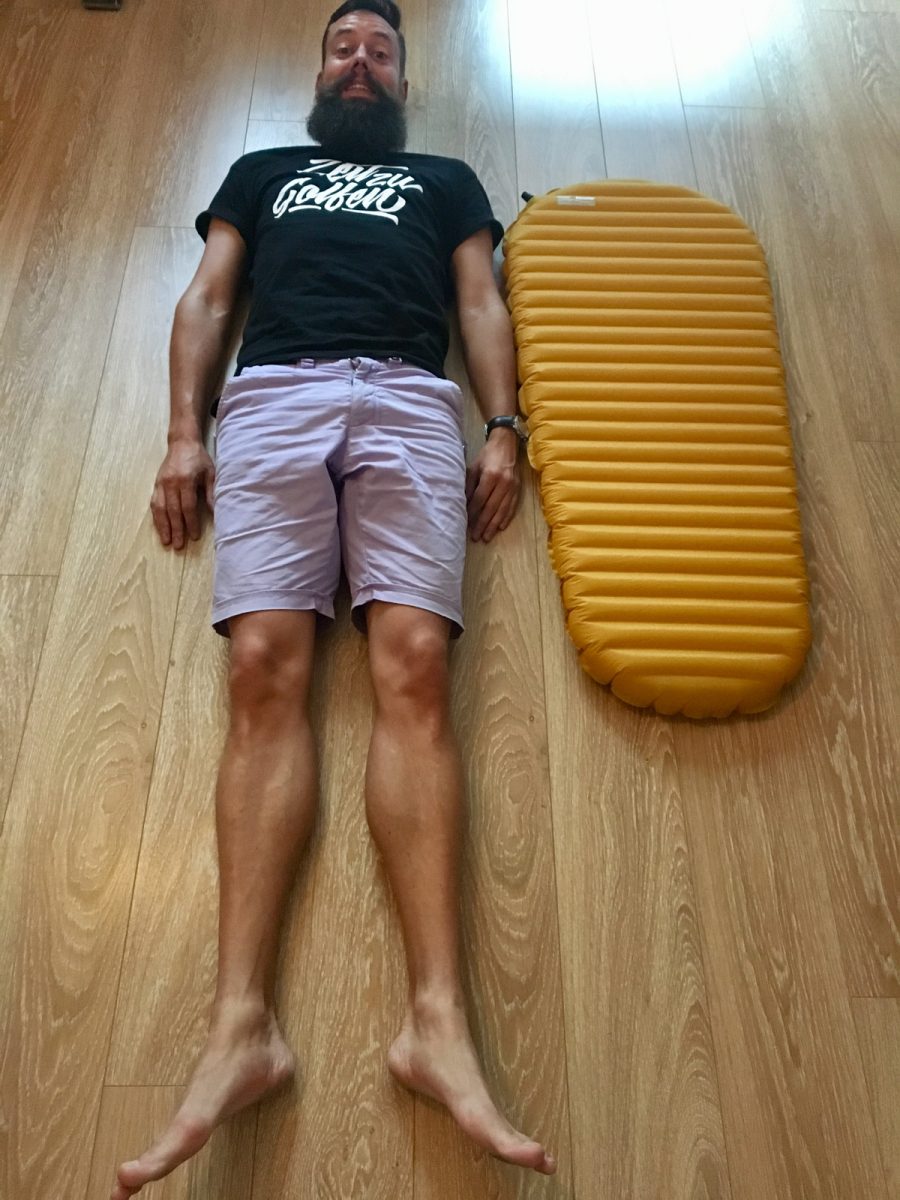
Cooking:
Some people go without a stove and only eat cold or dry stuff. Apparently it works but I wouldn't want to go without one proper meal per day. For this trip I switched from a normal light weight stove and pot to the Jetboil Zip. It is a bit heavier than my old setup but it makes cooking so much easier. In max. a minute the water is boiling, you can cook in wind and the gas efficiency is stunning. I only emptied a 230gr gas cartridge 2/3 in 20 days. Can you believe this? My Sea to Summit plastic spoon was on the tour again. My main water container is a cheap 1l Powerade plastic bottle - it does the job perfectly, is way lighter than the "proper" ones, the outflow of the

Powerade bottle has the perfect size so that you can drink while walking (better than the Powerade one), you can replace it once in a while if it gets to nasty and it costs almost nothing!
As a water filtration system I switched to a new system thanks to a tip from my friend Maria. I used to work with the Sawyers but this new tool changed my life. The sawyer was work and I always debated of filtering or not. The new Katadyn BeeFree water filter is amazing. It is almost like not filtering. The water flow is so fast that you can't drink in the speed the filter does its job. Incredible and one of my favourite new toys. I would definitely recommend to filter the water in the Pyrenees. Even in times when I thought it was impossible to encounter horses or cows I spotted them way above me.
I also have two stuff sacks (10l and 15l) for my food. It helps to easier squish the food into the backpack and I always separate breakfast & dinner from snacks. By doing that I can bury the breakfast & dinner bag in my pack and only have to take to bag with the snacks out during the day

Clothes:
I try to carry as little as I can. Therefore I don't take anything which can't be used on top of each other for the worst case scenario. Don't over pack - yes, you will be smelly and a bit sticky. But everybody is out there. You'll get used to it. Not showering for ten days sounds really bad at the beginning but it's actually not. And once in a while there is also a river to jump in if you are desperate 😉
I usually hike in a Icebreaker merino wool t-shirt, my beloved red/pink Speedo swim shorts, short Icebreaker merino socks and my favourite Salomon Speedcross trail runners.

this time I tried the new Salomon Speedcross 5 for the first time. I have to say they are better than the 4. They somehow managed to get rid of the weak-point on the front part. This is were the old ones all used to rip after 300km. This pair still looks like new after 900km and no signs of ripping. Really great!


To protect my socks and shoes from the insight I use very small Outdoor Research Sparkplug gaiters. As sun protection I have my new and cool Prana hipster cap 😎.
Rain gear: Outdoor Research Helium II rain jacket & Vaude Drop Pants II rain pants - for heavy conditions and when temperatures drop below 0C with rain and wind. And the above mentioned rain skirt Zpacks Rain Kilt. I would personally make it shorter and keep it over your knees for better movability.
For the really cold days I carry a thin Icebreaker merino beanie and a pair of Icebreaker Sierra gloves.

My new Mountain Hardware Ghost Whisperer Hooded Down Jacket had no chance to show how good it is. Not used a single time. But I would take it again - you never know.
One Icebreaker Descender Long Sleeve merino wool jumper - early in the morning or later in the day on cold and windy days I like to wear this one. Down is to warm to walk in but to save weight I would maybe consider leaving it behind next time. Let's see.
Since my swim shorts have a mesh inside I don't wear underwear. It also helps for better ventilation, less sweating and rubbing. So I only carry one pair of merino underwear to sleep in.
The only extras I carried were one Icebreaker merino t-shirt which is not really necessary - but it is nice sometimes if you are soaked after a day and you want to sleep in a dry shirt. But you don't need it. If its wet I either try to keep in on and dry it with body heat or I take it off and wear my jumper. It sucks in the morning to put it on again but after 20 minutes of exercising it's usually dry.
I also have one pair of extra socks in case a sock breaks down. This usually happens quickly. I went through a pair in 3-4 weeks. Your feet are the most important part on this journey - you do want to do anything possible to prevent blisters and/or injuries! Other than that you only need one pair. Why? How many can you wear? Exactly. If they smell you wash them in a break. If they are wet? Then you walk in wet socks. If it rains on consecutive days even dry socks are wet after 20 minutes so there is no sense in putting dry ones on to into your wet shoes...
Medics and Hygienics
How to go light: Try to buy the smaller sizes. No need to carry 200ml of something that will last for 2 month. Resupply more often. I have seen people carrying regular bottles of everything ending up with 3-4kg of liquids 🙈
My daily hygienics consisted out of a small and cut off tooth brush + toothpaste, contact lenses and cleansing fluid (extra pair and a few daily lenses in case of an eye infection), nail clipper, comb for my beard - therefore no razor 😂 and an amount of toilet paper suitable for the days - don't carry an entire roll!
In case shit happens. How much can you do in the wilderness? If it's a minor thing you usually don't really have to do anything and if it's a big thing (broken bones, etc.) you can't heal yourself anyways. So the only thing you have to do is get out and get help. So I am not a big fan of carrying a lot of stuff. For the heavy stuff I rely on painkillers (Ibuprofen), the cable ties and ductape.
I also carry Imodium for dhiaria (how many do you need? Not the entire pack for sure, just enough to get you out in case it hits you), a cream for eye infection which happens quickly with contact lenses, a couple disinfection/alcohol tissues (also work great if you have to clean camera lenses or surfaces before you repair / glue them). And a few Antihistamine pills after my shocking 25 sting-wasp-experience.
For the smaller issues and especially my feet I have a small roll of plaster tape (Mefix) which is a sticky plaster to seal open wounds and a 2m strip of Leuko Surgical Tape wrapped around a solid plastic tube: it's the only tape which really works. The adhesive is incredible and even stays on feet for days when they get wet. Don't try anything else!
Last but not least a 30ml sunscreen tube and a Ziploc bag to store everything.
(What I don't carry anymore different to before the trail and on the picture: Voltaren, Aspirin, hand sanitiser, bio degradable washing lotion, ear plugs)

Repair kit
Minimal as well. Tape and cable ties will fix most problems temporarily or even long term. For the electronics I only carry my iPhone for backup navigation (bad weather, emergency situations) and to write the blog.
Sufficient amount of ductape wrapped around my trekking poles so I don't have to carry it in the backpack fixes everything: equipment and also small injuries.
An Opinel Knife No. 6, a stripe of special waterproof repair tape for tents, rain jackets and repair kit for my air mattress, 6 cable ties, super glue, a spare lighter. On top I carried 4 one gallon Ziploc bags as emergency and rain gloves and socks and a small stuff sack to store everything.
Electronics and camera gear
USB charger with double port, my iPhone in a waterproof Catalyst iPhone case - also my fall back navigation and emergency (if I have reception) device, a Goal Zero Flip 20 Powerbank for two charges. A Black Diamond Ion headlamp for hikes during night time and everything else when it's dark. And I have a small Zpacks Wallet Zip Pouch for credit cards &, ID and all of it goes into a 3l Osprey Ultralight Dry Sack.
Photography is one of my passions. So I can't go without a proper camera. I tried to find a compromise between a full DSLR camera which is to bulky and heavy and a smaller one which will still give me a very high quality. For the last 2 years I have used my Olympus OM-D E-M1 II with a micro four thirds sensor and the Olympus M. Zuiko Digital ED 25mm 1:1.2 Pro lense. It almost weighs 1.500g including the lense, battery and memory card which is significantly less than a comparable SLR. It is pretty heavy but as I said - my only luxury piece of equipment.
On top I have 2 spare battery, 2 SD memory cards, cleaning wipes, a grey filter and the camera battery charger.
And I also finally found a way to attach my camera to my backpack so that I can always use it without taking my backpack off or it dangling around and being annoying. The Peak Design clip straps the camera to your shoulder belt. It's fixed, secured and you still have easy access to it. And after two years of heavy usage I can only highly recommend this thing including the shell to protect your camera from dust and rain. If you take the extra weight of a good camera with you this clip is a must item - if you have your camera in your pack you'll never use it and just carry dead weight around! Peak Design Capture Clip v3 for the backpack & Peak Design Shell for protection.

Additional gear
Leki Khumbu Lite hiking poles which I always use. It's said that they save you up to 30% of energy in your legs since you use your upper body which normally is not used when hiking.
Suunto Core Watch. Simple watch, altimeter and compass. I am not a fan of GPS watches since they use a lot of battery which you don't have out there.
Additional 32oz Gatorade (big opening) pee-bottle for the night. I hate getting out of the tent at night. Probably one of my most favourite items 😊
HRP - 23 days on the Pyrenean Haute Route - my tour summary, resupply points and gear list
HRP - Pyreneen Haute Route Tour Summary

I hiked the HRP eastbound from Hendaye to Banyuls-sur-Mer between the 17. July and 10. August 2019. I did about 840km in distance and roughly 100.000 meters in elevation. Since I only had limited time I hiked between 12 and 14 hours every day and with being a rather fast hiker I made it to Banyuls in 23 days (and 3 hours). So much to the hard facts.
The HRP has been an amazing hike! For me it was the first time in the Pyrenees. And what can I say. I had no clue how beautiful they are! I was really surprised by the amazing mountain landscape. I really loved the rough alpine terrain above the tree line. I have to admit that I am a big fan of the higher and rougher alpine areas and I do love long and steep uphill climbs. So the Pyrenees with mostly very grey and bright granite combined with the sparse vegetation were amazing in that sense already. But especially the very steep and long ascents made me very happy. Very often you just get 1.000 or 1.300m of straight uphill sections which are usually pretty steep. Exactly my cup of tea. Just to put this a bit into the right perspective - I have done a few other long-distance-trails like the Te Araroa in New Zealand, the PCT and quite a few hikes in Canada, the Alps and South America. So I do have seen quite a few mountain areas already but the Pyrenees made it to the very top of the list. I will definitely come back to do more hikes here.
HRP Weather

I hiked between 17. July and 10. August and I guess it has been another very hot summer. I started in a heat wave with over 40C on sea level. I woke up at 6 o'clock at Source de Marmitou with still 23C. So it's probably (hopefully) not a representative year. I had really hot days with mid 30s in the valley along the way. I had two days of rain between Gavarnie and Parzan. But besides this I had quite a few days in the clouds with a few showers in between but mainly hot and sunny days. I was hit by four small thunderstorm or rather cells but they all hit me during the night which was not a problem. I think the coldest night I had was at Lac de Caillauas (2.160m) just before I crossed Col Inférieur de Literole and that was around 4C in the morning.
Because of the warm weather I never really hat the need for warm clothes. I always walked in my Speedo swim-shorts and a t-shirt. I did put my merino-wool sweater on once in a while early in the morning or when I was in the clouds. But my small puffy stayed in the bag the entire trip and also my +6C sleeping bag was only zipped up four or five times. The other nights I only used it as a blanket.
HRP Resupply points

I started out from Hendaye with way too much food - probably for almost 5 days. But I wanted to see what "limited resupply" actually meant. Looking back I can only say that when "limited resupply possibility" was quoted I found more than enough to find enough for the next stretch. Maybe you don't find your favourite brand or flavour and sometimes you might have to get creative but you won't starve and will be fine. I also used may resupply points to just get extra meals and calorie boosters. I knew that I would never be able to keep a balance with my calories. So if there was a shop on the way I made sure to get two cans of coke, fruits, bread, olives, coffee, chips, yogurt and whatever I could get and I was too lazy to carry as a snack.
So my resupply and food points were:
Day 1. Resupply: Henaye
Day 2. Resupply: Les Aldudes (great shop): just a few things to stock up
Day 4. Calorie booster: Col Bagargui - had yogurt, milk, fresh fruit and they even had dehydrated meals.
Day 6. Resupply and 2. Breakfast: Lescun (all you need), great coffee
Day 7. Calorie booster: Candanchu supermarket & cafe
Day 9. Calorie booster: Oulettes de Gaube
Day 9. Resupply: Gavarnie
Day 10. Dinner: Heas
Day 11. Resupply: Parzan
Day 13. Dinner: Hospital de Benasque
Day 15. Resupply and Lunch: Salardu / Vielha
Day 17. Lunch: Refugio de Certascan
Day 19. Resupply & breakfast: l’Hospitalet-près-l’Andorre
Day 21. Resupply & breakfast: Bolquere
Day 23. Resupply and Lunch: Amelie les Bains
Day 24. Resupply and 2. Breakfast: Le Perthus
HRP Clothes & Equipment

Here you will find my complete equipment list of the trip: HRP gear list.
In the mean-time you can just check out the gear page. The gear list from the TMB is very close to the final HRP gear list. But the update will come soon.
Even though it was a very hot summer I would be totally fine to take the same equipment with much colder weather.
Planning the HRP
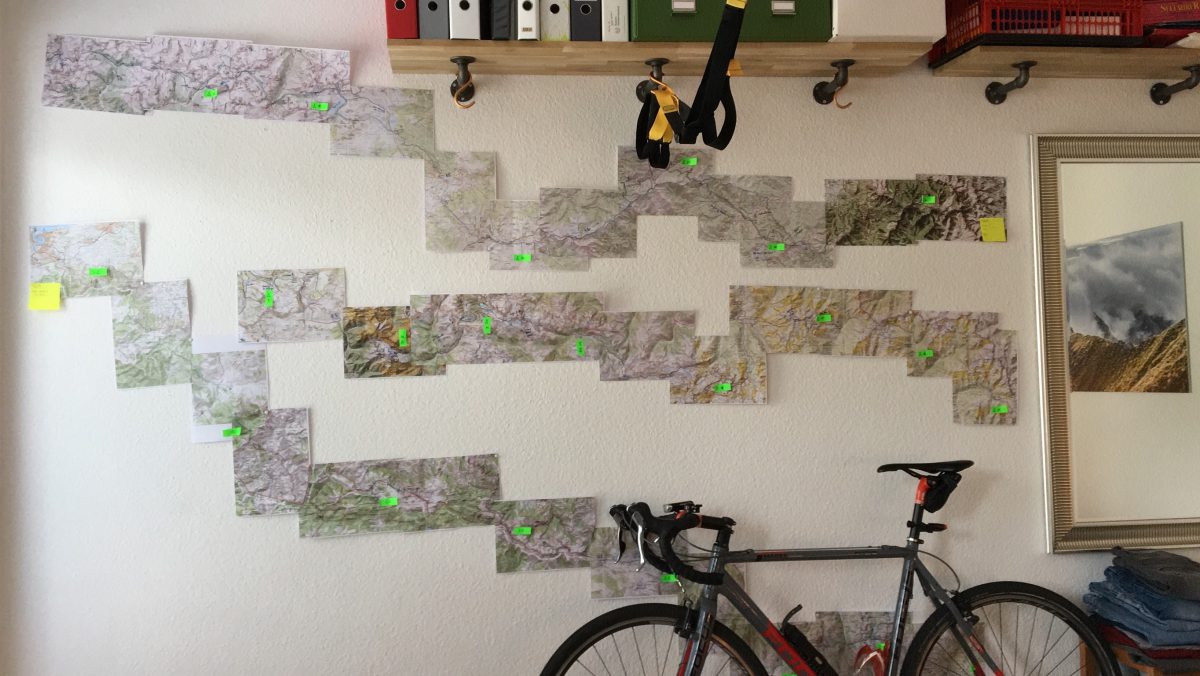
When I started planning the HRP tour I found the following sources very helpful:
Great and short notes for the hike, good description of alternates and GPS files. Really helpful once you get into the real preparation phase of the tour: Whiteburn's Wanderings
I also used Chris' blog as point of reference for my stages. He pretty much hiked the same speed and distance. So it was very helpful to have his stages to see where I would end up at the end of the day or what was possible. Chris
And of course Tom Martens Facebook group is an amazing source: HRP
Besides this I only used the iOS App maps.me with the GPS files from Whiteburn and Google maps in towns. Sometimes I used the mountain weather forecast when I needed updates for the peaks.
I also carried paper maps (just the pieces I needed) and the short notes from Whiteburn. I do like the paper maps when I am alone. I had a situation already where my phone died on me in a river and I was glad I had maps to get out. 1:50.000 maps do not really work for navigation if the trail is not clear. But to have an overview and to plan the next day it was always helpful and saved a lot of battery power.
Best sections of the HRP

I really liked the entire section between Lescun and Canigou. Of course there were a few more and less stunnig sections but overall it was amazing all the way. From Lescun the really high mountains were building up, then you were in the really high section for a long time but also coming out again at then end looking at the high stuff behind and the rolling hills again was great. Pic Carlit and the ridgewalk afterwards were surprising highlights of the trip!
Worst section of the HRP
Two sections I would not do again anymore:
The valley after Refugio de Certascan - it was dangerous and completely unnecessary since there is also a good trail in the neighbour-valley. See the detailed post from Day 17.
+++ Update +++
Thanks Paul for the hint. Here is a screen shot of the map and the alternate after Refugio de Certascan to avoid the horrible descent:

+++ Update +++
Also the entire section around Airoto and down to Alos d'Isil was just horrible. No trails, very tyring overgrown boulder fields and steep bushwacking down to Alos d'Isil. I would try to find a work-around next time. See Day 16.
Fun facts

I did not sleep in a refugio a single night but always in my tent. I camped on an official campsite in Gavarnie because of the expected thunderstorm and next to the Refugio in Heas, Wallon and Sorteny for various reasons.

I cooked every night with my Jetboil stove besides 4 nights were I got food in town, a refugio or carried prepared food out on the first day. I carried a 230gr gas cartridge which was still 1/3 full when I arrived in Banyuls. Unfortunately I did not find the small 100gr version in Hendaye. I would have preferred to buy a new one half way.
I managed to not take a single shower on the trip. I dipped into rivers and lakes though but of course always without using soap out there. Leave No Trace (LNT)!
Hiking the HRP day by day
Here you can find the detailed day by day HRP articles. I tried to put points of reference, refugios or stages from the Cicerone guide into the start and end of a day so it is easier to find them on the map. The exact start and end point of the day can be found in the article. Hope this makes it easier finding the spots.
Day 1: Hendaye to Col-d'Inzola
Day 2: Col d'Inzola to Les Aldudes
Day 3: Les Aldudes to Harpea Cave Valley (below Errotzate)
Day 4: Harpea Cave Valey to Pic d'Ory
Day 5: Pic d'Ory to Source de Marmitou
Day 6: Source de Marmitou to Pla d'Espelunguere
Day 7: Pla d'Espelunguere to Valle Darrious
Day 8: Valle Darrious to Refuge Wallon
Day 9: Refuge Wallon to Gavarnie
Day 12: Parzan to Lac de Caillauas
Day 13: Lac de Callauas to Basurta
Day 15: Lac de Mar to Estany de Baix de Baciver (close to Salardu / Baqueira)
Day 16: Estany de Baix de Baciver (Salardu / Baqueira) to Estany de la Llavera
Day 17: Estany de la Llavera to Cabana de Basello (close to Estany de Baborte)
Day 18: Cabana de Basello to Refugi de Sorteny
Day 19: Refugi de Sorteny to l’Hospitalet-près-l’Andorre
Day 20: L’Hospitalet-près-l’Andorre to Estany de la Pradella (close to Auberge du Carlit)
Day 21: Estany de la Pradella to Refuge de la Porteille Rojta
Day 22: Refuge de la Porteille Rojta to Refuge de Batere
Day 23: Refuge de Batère to Las Illas
Day 24: Las Illias to Banyuls-sur-Mer
HRP - Pyrenean Haute Route
2019: HRP - Pyreneen Haute Route / La Ruta Alta Pirenaica
In July and August I finally made it back into the mountains again for a longer trip. From the Atlantic Ocean over the highest passes and peaks of the Pyrenees to the Mediterranean Sea - 840km and 100.000 meters in elevation change. Took me 23 days to hike from Hendaye to Banyuls-sur-Mer. No rest day, 12-14h of hiking every day and short nights in my tent.
TMB - Tour de Mont Blanc Gear List
Background
I hiked the Tour de Mont Blanc (TMB) in 2018 after having done the Te Araroa and the Pacific Crest Trail in the two years before. So I had accumulated a lot of hiking and long distance experience. On these two long distance trails I tried out a lot of different gear and also learned a lot. When I started in New Zealand I was completely over-packed! I had a 75l backpack and carried about 16kg of base weight! Only after three weeks I had the first big "roll-over" where I changed my tent, shoes, backpack and also ditched a lot of stuff.
Changing and reducing gear has almost been a sport since then. Looking back now on how carefully I changed and decided not to carry the one or other extra I almost can't believe how much I voluntarily carried 😂 But I also have to admit that without going through the process myself I would probably not be as convinced of my setup now. I also would have felt uncomfortable with some of the stuff I am doing now (not taking) without the first hand experience. Based on the knowledge I have now and also the confidence in my own capabilities eg. with cold, wet, dry and injuries I still feel safe with the minimal equipment.
Tour de Mont Blanc - 4 days and camping
Since we only had four days in total we had to go very light and we also wild-camped every night. We also carried all food for the first two days until we were surely able to resupply in Courmayeur. We wanted to be independent from huts and daily limits with our hikes. It paid off well. We did the entire circuit in 4 days and 3 hours. It meant a daily average of 12-14 hours of hiking but it was doable.
When I tried to plan the route, trip and especially the days needed in advance I did not find any sufficient information about people doing it on their own in a relatively short amount of time. Most people take 6-10 days. Because of this I also didn't find any appropriate information about the gear to take and also the recommended daily sections. Here you go.
Since we hiked together of course we were able to share a few pieces of equipment like the tent and the stove. But to make it easier to follow I will post the full gear list for a solo hike.
What to pack?
Pointing it out again - everybody has a different comfort zone! So there is no right or wrong. You should never risk your health or even life by under packing and not being prepared! If you don't feel comfortable take whatever makes you comfortable! You can still throw stuff out on the next re-supply stop but you can't "get it" in the middle of nowhere if you need and don't have it with you.
In general I do recommend the same stuff I carried on the PCT at the very end. Of course it very much depends on the season you go. If you go during the high summer it is less likely to get really cold temperatures. Nevertheless you are in the Alps. Depending on your altitude and the weather system you can get temperatures below freezing, thunderstorms and any hazardous conditions you can encounter in the mountains. At the end you are in a high altitude mountain area.
The entire gear list in a quick overview:
|
Item
|
Product
|
Weight
|
|
The hiking outfit
|
||
|
T-shirt
|
130g
|
|
|
Shorts
|
130g
|
|
|
Socks
|
40g
|
|
|
Shoes
|
650g
|
|
|
Gaiters
|
34g
|
|
|
Sun protection
|
100g
|
|
|
Trekking poles
|
600g
|
|
|
Watch
|
64g
|
|
|
1.748g
|
||
|
The big three
|
||
|
Backpack
|
811g
|
|
|
Pouch for backpack
|
14g
|
|
|
Tent
|
539g
|
|
|
Stakes
|
MSR Ground Hog Mini tent stakes (8)
|
80g
|
|
Sleeping bag
|
595g
|
|
|
Waterproof stuff sack
|
25g
|
|
|
Sleeping pad
|
Therm-a-Rest NeoAir Xlite (small - 119cm)
|
230g
|
|
2.294g
|
||
|
Cooking
|
||
|
Cooking pot
|
Trangia Pot incl. handle
|
142g
|
|
Stove
|
83g
|
|
|
Fire
|
Lighter
|
10g
|
|
Spoon
|
10g
|
|
|
Water filter
|
91g
|
|
|
Water container
|
40g
|
|
|
Water Bottle
|
Powerade
|
50g
|
|
Food bag
|
28g
|
|
|
454g
|
||
|
Cloth
|
||
|
Rain jacket
|
180g
|
|
|
Rain skirt
|
54g
|
|
|
Rain pants
|
180g
|
|
|
Down jacket
|
360g
|
|
|
Jumper
|
376g
|
|
|
Beanie
|
32g
|
|
|
Neck gaiter
|
40g
|
|
|
Gloves
|
40g
|
|
|
Socks
|
40g
|
|
|
Stuff sack
|
55g
|
|
|
1.257g
|
||
|
Medics & Hygienics
|
||
|
Teeth
|
Half tooth brush
|
7g
|
|
Teeth
|
Tooth paste
|
24g
|
|
Contact lenses
|
Case, solution, extra pair
|
80g
|
|
Eye
|
Eye infection creme
|
3g
|
|
Nails
|
Standard small nail clipper
|
21g
|
|
Beard
|
Comb
|
6g
|
|
Toilet paper
|
Amount depends on days.
|
30g
|
|
Pain killer
|
Ibuprofen
|
15g
|
|
Diaria
|
Imodium
|
4g
|
|
Disinfection
|
4 alcohol pads
|
1g
|
|
Tape
|
2m of Leuko Surgical Tape
|
30g
|
|
Antihistamine
|
6 capsules
|
7g
|
|
Sunscreen
|
30ml
|
34g
|
|
262g
|
||
|
Repair kit
|
||
|
Tape
|
Ductape wrapped around trekking pole
|
|
|
Fixation
|
6 cable ties
|
6g
|
|
Knife
|
28g
|
|
|
Repair gear
|
1m Dyneema Composite Fabric
|
60g
|
|
Repair gear
|
Special tape for air mattress
|
10g
|
|
Repair gear
|
Tenacious tape
|
15g
|
|
Repair gear
|
Super glue
|
15g
|
|
Stuff sack
|
15g
|
|
|
149g
|
||
|
Electronics
|
||
|
Charger
|
USB with double port & iPhone cable
|
66g
|
|
Battery pack
|
135g
|
|
|
Phone & navigation
|
iPhone 6S
|
145g
|
|
Waterproof case
|
35g
|
|
|
Headlamp
|
55g
|
|
|
Battery
|
2 spare batteries for headlamp
|
22g
|
|
Wallet
|
7g
|
|
|
Stuff sack
|
20g
|
|
|
485g
|
||
|
Camera
|
||
|
Camera
|
Olympus OMD EM1 II (incl. battery & SD)
|
390g
|
|
Lense
|
M.ZUIKO Digital ED 14-150mm 1:4.0-5.6 II
|
285g
|
|
Battery
|
2 extra Olympus batteries
|
90g
|
|
Memory card
|
2x SanDisk Extreme Pro 64GB
|
40g
|
|
Camera clip
|
84g
|
|
|
Camera rain cover
|
Peak Design Shell small
|
113g
|
|
Charger
|
Olympus charger & cable
|
115g
|
|
1.117g
|
||
|
Additional Gear
|
||
|
Pee-bottle
|
Gatorade 1l bottle
|
50g
|
|
50g
|
||
|
Total base weight
|
4.845g
|
|
|
Total base weight incl. camera
|
6.018g
|
|
|
Weight on the hiker
|
1.748g
|
|
As summarised earlier for the PCT already:
Backpack:
Most important with a backpack is that it fits your back. They all have different harnesses and fit different backs. So make sure to try many. The other features are less important. If you carry heavier loads >15kg you want to have a good hip belt or otherwise you will have bruises on your hips and it's uncomfortable on longer hikes.
My backpack of choice is now the Hyperlite Mountain Gear 2400 Southwest. It's specially designed for ultra-light hikers with a 40l volume and only weighs 811g (in comparison my Osprey 50l bag weighs about 1,8kg!) and it is waterproof in itself. It helps you only taking the things you really need since there is not a lot of space 😉. As a reference my bag is maybe half full with all my gear. The rest is "reserved" for food and I usually fit 5 days in it easily. I would not recommend it with a permanent weight over 15kg, but if you exceed it in the first days of a long hike because of food it should be ok since you will get lighter every day.
I also have a Zpacks Backpack Shoulder Pouch on one of my shoulder straps for my phone, ND filter and snacks.

Tent:
Since we were two for the trip we shared the Zpacks Duplex. It is made out of Dyneema Composite Fabric (also known as Cuban Fibre) which is highly durable and super lightweight with 539g only! Including 8 stakes with 60g the total weight of the tent comes down to 599g. Comfort, space and durability are amazing. Keep your vestibules open for ventilation since in a single wall tent you do get condensation very quickly. It's not cheap with 555US$ but it's well worth every cent if you sleep in it every day.

Sleeping bag & sleeping pad:
The lightest and smallest version is always down. The higher the number of the filling (e.g. 850) the better the quality of the down and therefore the less you need for the same insulation. As mentioned above I would go with the Western Mountaineering Summerlite sleeping bag which is rated for +6C comfort and a max of 0C. I only had a 3 or 4 cold nights below freezing and used used my rain jacket and my backpack as a sack wrapped around my feet for extra insulation in cold nights - just make use of whatever you have if you need it.
Due to packing size I opted for an inflatable sleeping mattress. I am not a fan of the bulky foam pads which you always have to attach to the outside dangling around. The Therm-a-Rest NeoAir Xlite is the lightest one. I used to have a large one but now I go with the extra small one (119cm) since I put my legs on my backpack and other things. Saves 200g compared to the large/regular one.

Cooking:
Some people go without a stove and only eat cold or dry stuff. Apparently it works but I wouldn't want to go without one proper meal per day. So I carry a very small and light weight (83g) gas stove from Optimus Crux and a small gas canister. For cooking I have a 1.5l Trangia hardanodized ultralight aluminium cooking pot, the aluminum handle and Sea to Summit plastic spoon.
My main water container is a cheap 1l Powerade plastic bottle - it does the job perfectly, is way lighter than the "proper" ones, the outflow of the Powerade bottle has the perfect size so that you can drink while walking (better than the Powerade one), you can replace it once in a while if it gets to nasty and it costs almost nothing! As a water filtration system you can go with the lighter Sawyer Mini instead of the Sawyer Squeeze. I only filtered my water 4 or 5 times on the entire trail. Since there is water everywhere in New Zealand and you rarely have two hours without a water source you can either carry a 2l Platypus or get an additional thin water bottle for the few occasions where you will need it.
I also have two stuff sacks (10l and 15l) for my food. It helps to easier squish the food into the backpack and I always separate breakfast & dinner from snacks. By doing that I can bury the breakfast & dinner bag in my pack and only have to take to bag with the snacks out during the day
(What I don't carry anymore different to before the trail and on the picture: camel bag, water bottle)
Clothes:
I try to carry as little as I can. Therefore I don't take anything which can't be used on top of each other for the worst case scenario. Don't over pack - yes, you will be smelly and a bit sticky. But everybody is out there. You'll get used to it. Not showering for ten days sounds really bad at the beginning but it's actually not. And once in a while there is also a river to jump in if you are desperate 😉
I usually hike in a Icebreaker merino wool t-shirt, my beloved red/pink Speedo swim shorts, short Icebreaker merino socks and my favorite Salomon Speedcross4 trail runners. To protect my socks and shoes from the insight I use very small Outdoor Research Sparkplug gaiters. As sun protection I have my new and cool Prana hipster cap 😎.
Rain gear: Outdoor Research Helium II rain jacket & Vaude Drop Pants II rain pants - for heavy conditions and when temperatures drop below 0C with rain and wind. And the above mentioned rain skirt Zpacks Rain Kilt. I would personally make it shorter and keep it over your knees for better movability.
My Patagonia Nano Puff jacket with Prima Loft Gold is the piece which keeps me warm in camp or breaks - very small and very warm. I find Prima Loft better on long distance hikes since it even warmth you if it's wet, it dries quickly and you can easily wash it - different to down.
One Icebreaker Descender Long Sleeve merino wool jumper - early in the morning or later in the day on cold and windy days I like to wear this one. Primaloft or down is to warm to walk in.
For the really cold days I carry a thin Icebreaker merino beanie, a Buff (neck gaiter) and a pair of Icebreaker Sierra gloves.
Since my swim shorts have a mesh inside I don't wear underwear. It also helps for better ventilation, less sweating and rubbing. So I only carry one pair of merino underwear to sleep in.
The only extras I carried were one Icebreaker merino t-shirt which is not really necessary - but it is nice sometimes e.g. in towns after a shower when waiting for the laundry to be done. But you don't need it. If its wet I either try to keep in on and dry it with body heat or I take it off and wear my jumper. It sucks in the morning to put it on again but after 20 minutes of exercising it's usually dry. In Oregon I changed one Icebreaker t-shirt for a long sleeve shirt because of the mosquitos and kept it to the end. I also have one pair of extra socks in case a sock breaks down. This usually happens quickly. I went through a pair in 3-4 weeks. Your feet are the most important part on this journey - you do want to do anything possible to prevent blisters and/or injuries! Other than that you only need one pair. Why? How many can you wear? Exactly. If they smell you wash them in a break. If they are wet? Then you walk in wet socks. If it rains on consecutive days even dry socks are wet after 20 minutes so there is no sense in putting dry ones on to into your wet shoes...
(What I don't carry anymore different to before the trail and on the picture: hat, rain skirt, thermal pants, towel)

Medics and Hygienics
How to go light: Try to buy the smaller sizes. No need to carry 200ml of something that will last for 2 month. Resupply more often. I have seen people carrying regular bottles of everything ending up with 3-4kg of liquids 🙈
My daily hygienics consisted out of a small and cut off tooth brush + toothpaste, contact lenses and cleansing fluid (extra pair and a few daily lenses in case of an eye infection), nail clipper, comb for my beard - therefore no razor 😂 and an amount of toilet paper suitable for the days - don't carry an entire roll!
In case shit happens. How much can you do in the wilderness? If it's a minor thing you usually don't really have to do anything and if it's a big thing (broken bones, etc.) you can't heal yourself anyways. So the only thing you have to do is get out and get help. So I am not a big fan of carrying a lot of stuff. For the heavy stuff I rely on painkillers (Ibuprofen), the cable ties and ductape.
I also carry Imodium for diaria (how many do you need? Not the entire pack for sure, just enough to get you out in case it hits you), a cream for eye infection which happens quickly with contact lenses, a couple disinfection/alcohol tissues (also work great if you have to clean camera lenses or surfaces before you repair / glue them). And a few Antihistamine pills after my shocking 25 sting-wasp-experience.
For the smaller issues and especially my feet I have a small roll of plaster tape (Mefix) which is a sticky plaster to seal open wounds and a 2m strip of Leuko Surgical Tape wrapped around a solid plastic tube: it's the only tape which really works. The adhesive is incredible and even stays on feet for days when they get wet. Don't try anything else!
Last but not least a 30ml sunscreen tube and a Ziploc bag to store everything.
(What I don't carry anymore different to before the trail and on the picture: Voltaren, Aspirin, hand sanitizer, bio degradable washing lotion, ear plugs)
Repair kit
Minimal as well. Tape and cable ties will fix most problems temporarily or even long term. For the electronics I only carry my iPhone for backup navigation (bad weather, emergency situations) and to write the blog.
Sufficient amount of ductape wrapped around my trekking poles so I don't have to carry it in the backpack fixes everything: equipment and also small injuries.
An Opinel Knife No. 6, a stripe of special waterproof repair tape for tents, rain jackets and repair kit for my air mattress, 6 cable ties, super glue, a spare lighter, a 10m MSR Ultralight Utility Cord (cloth line, rope to hang food and possible repair kit) and 2 small carabiners to hang food. On top I carried 4 one gallon Ziploc bags as emergency and rain gloves and socks and a small stuff sack to store everything.
Electronics
USB charger with double port, my iPhone in a waterproof Lifeproof Case - also my fall back navigation and emergency (if I have reception) device, a Goal Zero Flip 20 Powerbank for two charges. A Black Diamond Ion headlamp for hikes during night time and everything else when it's dark. And I have a small Zpacks Wallet Zip Pouch for credit cards &, ID and all of it goes into a 3l Osprey Ultralight Dry Sack.
(What I don't carry anymore different to before the trail and on the picture: compass & maps which you won't need for the PCT)
The only luxury equipment - my camera
Photography is one of my passions. So I can't go without a proper camera. I tried to find a compromise between a full DSLR camera which is to bulky and heavy and a smaller one which will still give me a very high quality. For the last 2 years I have used my Olympus OMD EM10II with a micro four thirds sensor and the M.ZUIKO DIGITAL ED 14–150mm 1:4.0–5.6 II lense. It only weighs 1018g including the lense, battery and memory card which is significantly less than a comparable SLR.
On top I have 2 spare battery, 2 SD memory cards, cleaning wipes, a grey filter and the camera battery charger.
And I also finally found a way to attach my camera to my backpack so that I can always use it without taking my backpack off or it dangling around and being annoying. The Peak Design clip straps the camera to your shoulder belt. It's fixed, secured and you still have easy access to it. And after two years of heavy usage I can only highly recommend this thing including the shell to protect your camera from dust and rain. If you take the extra weight of a good camera with you this clip is a must item - if you have your camera in your pack you'll never use it and just carry dead weight around! Peak Design Capture Clip v3 for the backpack & Peak Design Shell for protection. Use the link to get a free gift 😉
PS: Unfortunately my camera went swimming 3 weeks before the end. So I had to replace it on the go. I have to admit that I used this excuse to directly upgrade to the OMD EM1 II with a 12-100 Pro Lense. It is significantly heavier (+460g) but I will also use it for non hiking purposes now. On long hikes I might try to use the old lense if I can repair it. For the packing list I include my old camera since it was the one I used.
Additional gear
Leki Khumbu hiking poles which I always use. It's said that they save you up to 30% of energy in your legs since you use your upper body which normally is not used when hiking.
Suunto Core Watch. Simple watch, altimeter and compass. I am not a fan of GPS watches since they use a lot of battery which you don't have out there.
Additional 32oz Gatorade (big opening) pee-bottle for the night. I hate getting out of the tent at night. Probably one of my most favorite items 😊
Re-socialise VI: Already on year ago to the day I returned from my "break"...
One year ago to the day
It's unbelievable! But it has already been a year since I finished the last big adventure of my "break". On Thursday exactly one year ago I came back from Canada to Germany. And only a few days before that I finished the Pacific Crest Trail and arrived in Canada - 22. October 2017. After 2,650 miles, tons of snow, water and many fires we crossed the border in the morning and were "done".
At this point of time I had no clue what was going to happen next. No clue. The only thing I knew was that I just fell out of my new comfort zone. Living in a tent, just getting up, a few granola bars to get started, hiking all day, finding a spot to pitch a tent and only caring about the very essential things was my new comfort zone. And I had decided to leave it again. Not because I didn't like it. Not at all. But you probably all remember this one:
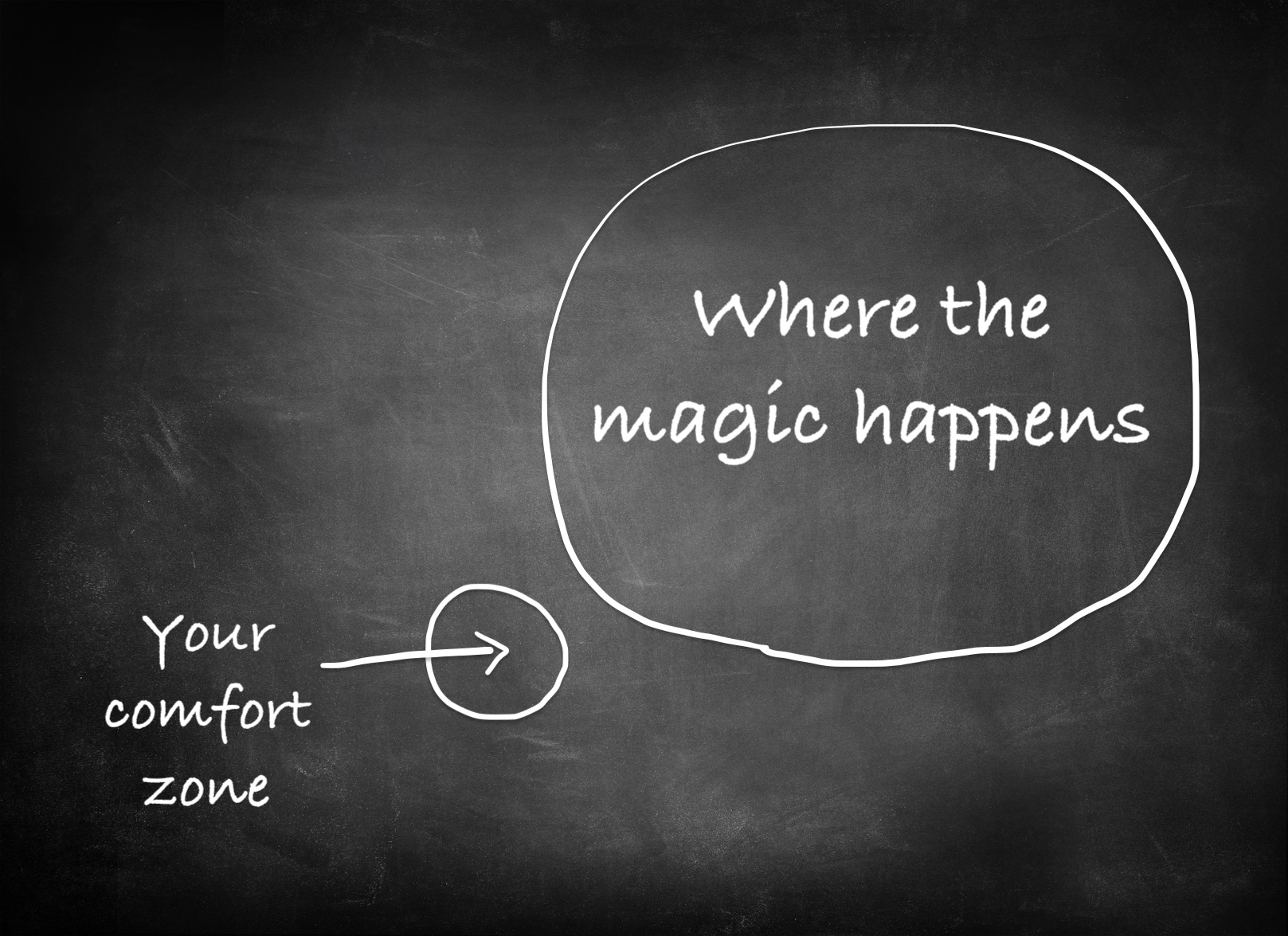
Let's start out with the day I arrived in Canada. One year later to the day I woke up exactly the same way as on the trail - in my tent. A bit of a different set up on our annual "Guys Adventure Weekend" but still in a tent on a sleeping pad and in my sleeping bag. Awkward. Pure coincidence? I don't know. But I did have a lot of thoughts and memories flowing through my head this morning.
Many things have changed. Many things have not
I knew that I had to move on, and not to a different trail but somewhere completely different to keep on growing. Many things have happened since then. Many things have changed. Many things have not.
I have thought about what has happened during the last year a lot. I have also been asked about what has changed, what has changed back "to old" and what I was able to keep. Time to look back and see. I went back and read the articles I wrote in the weeks and month after my return trying to capture my thoughts, reflections, ideas for the future and checked myself what turned out to be true and false or developed differently.
Sharing a place to live
Well, where am I now? I am still living in a shared apartment which I truly enjoy. My plan not to be able to withdraw into my own four walls and maybe fall into old habits worked out. Living together with others rewarded me with two things. Firstly the need to share and make compromises which helped me in not falling back into old habits, in not getting cranky and training my tolerance on a daily level. And on the other side purely enjoying community spirit of give and take and fantastic people around you enriching my life with stories, laughter and good food ;-)

Mountains
What I have not accomplished so far is to be living closer to the mountains. Due to my obligation with our startup company campo I am and will be staying in Mainz for some more time for sure. So for now it's only a few escapes back into the mountains and the outdoors for a few days. But it shows that they have kept their unbroken fascination on me and I always feel home seeing and getting into them.

Can I escape all-day-life? No.
Yes, an all day life has arrived. I do live in a (shared) place since April. I do go to our office in a Coworking space pretty much every day. Sometimes on the weekends but in the last weeks the weekends have been kept "work-place free". Not that we are not also doing stuff on the weekends but life has adopted a bit more to our surroundings and their schedules as well.. And we do have regular things going on. We have breakfast together in the morning. We have ordered an organic box of veggies every week from a local farm for our lunch-cooking sessions every day. Yes, it is a routine. Also work does not have real boundaries to "the private life" anymore. They mingle, go together and just happen parallel. But therefore - for most of the days - work is always mixed with a lot of joy and fun activities. May it be the cooking or the night-shifts of GTA 5 in larger-than-life size. It is not a work time and then private time. They go together hand in hand. So fun during the work seems as right as work during the weekend. Even though - I have to admit to myself I guess - that work has the majority and the fun events have been a bit to little during the last weeks.

Work-Life-Balance? 100% left and/or right is my balance. That's it.
This leads me to another finding. I asked myself the question already once. Can I balance work and life better like others. Like one of my good friends maybe? I think I can't. And I accepted. I can't go for 80% and relax. At least not now. I always do things 100% or more. I guess my balance lies in the extreme 100% but not the chilled things. If there is something to do, an opportunity or whatever I will go for it. Either until it is done or until I am done. And only then I move on. I do accept that this has and probably will not change.
I have become softer and more mellow
But other things have changed. I have been asked many times already what has changed the most or at all after my travels. And also what has changed back to "old" now. What has been the biggest change in life.
Right now I always reply that I don't have changed in general. I am still the same personality. My core values are still pretty the much the same. But I have evolved and developed in many areas. I tend to say that I have become softer and more mellow. I am the same but with polished edges. How does this show?
I am still resting within myself. There are no things that really kick me off the balance anymore. And if I start loosing this balance using my "Koru" as anchor still works. Just looking at where it is immediately puts me back into this balanced state of mind. I hope I can kept this forever (or at least for a long time). Things that would have annoyed or upset me early don't get me that easily anymore. My resilience is a lot stronger.
I am still very happy. Happy with my life. My setting. My surroundings. My everything. I still catch myself smiling out of the blue in public. I kept the attitude and the mental freedom of being able to just change things which I don't want to continue. With this all things become a conscious choice. Being conscious means that they are wanted and chosen. And if - at one point of time - they are unwanted they can be changed. With this even tough days are easier to deal with since they feel part of a wanted greater.
With this I have become more tolerant as well. Things that would have droven me nuts a few years ago I do see them as a different way of doing things. People have different priorities and different ways of doing things. Accept things you can't change and see if they can somehow put a smile on your face. I am also still very careful with my judgements. After being called judgemental by someone who I really admire I have been very careful with this discipline. I still judge. Pretty quickly. But I have trained myself to always start a second thought with something like "What's the story behind that it has come to this point?", "That's the easy call but what's behind the obvious?". This leads to more understanding, more openess and many interesting encounters. Still.
When it comes to material things I have been extremely good. I have not accumulated any additional stuff. Contrary to what I was afraid of I have reduced even further. Whatever has not been used or touched for a while had to go. Nothing has been sourced in without something else sourced out. I really enjoy not having a lot of responsibilities at the moment. I don't have a lot of stuff, I don't have (a real) rental agreement to take care of and I don't even have a single plant to take care of. I am pretty sure it will change at one point of time again but for now it feels good. Probably since it is such a dramatic contrast to how it was before.
On a side note - I still greet the bus drivers. Maybe not with the same enthusiasm anymore screaming from the last door to the very front but always when I leave or entere the bus through the front door. Maybe something I have to re-focus on.
One thing which annoys me massively is how much time I spend on my phone again. And I am not talking about talking on the phone. Partly it is a result of having one phone and mixing private and work life so borderless. But if I am honest to myself I also spend a lot of unnessary time on it. I definitely improved on the no-go-times. During meals, in conversations with other or any kind of interaction my phone is gone. But between these phases I am not very disciplined anymore. The "time to refelect when waiting for a bus" doesn't really happen anymore. Something which has caught me quickly.
There are probably many more things which I can't fully capture at this point of time. But in general I have the feeling my ressilience to influences from the outside is a lot stronger. Sitting in Munich with sneakers, shorts and hoody while everyone else is wearing good shoes, expensive watches, purses, button shirts and expensive labels everywhere else I couldn't care less.
And I have come to the conclusion that some things have changed for good. I don't think that I will be able to ever ignore or deny them anymore. They have just changed.



